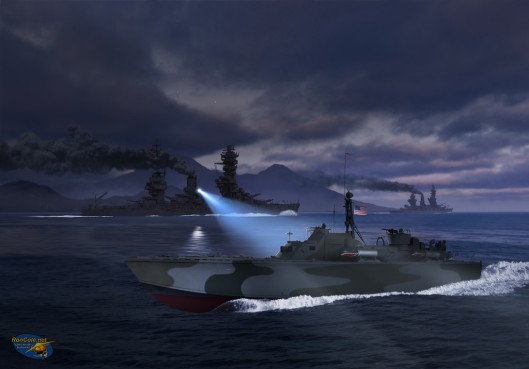
Battle of Surigao Strait – US Navy PT Boats, IJN Fuso & Yamashiro.
PTs 130, 131, and 152, three of six boats positioned furthest into the Mindanao Sea, were the first to spot the Japanese on radar. As the Japanese ships drew close, the three boats revved engines and dashed south. By 11:50 P.M., they actually saw the Japanese ships and began transmitting contact reports by radio. Within moments, lookouts on destroyer Shigure spotted the PTs. While Fuso and Yamashiro hung back, Shigure turned on searchlights, lofted illuminating star shells over the PTs, and advanced to confront them. Seconds later, 4.7-in. projectiles from Shigure’s main batteries bracketed the PTs. The Battle of Surigao Strait began.
To Bob Clarkin on the 152 Boat, the next moments were a riotous blur. “The first thing I remembered was the boat hauling ass away. We hadn’t fired torpedoes and we were caught in a searchlight. The noise was incredible.” Bob heard an explosion forward. “Charlie Midgett, the guy on the bow thirty-seven-millimeter gun was down. He looked pretty bad to me. He probably died right away.” Fires flared topside and below decks. “Some of the guys carried Charlie and a couple of wounded down to the skipper’s cabin. The mattresses in crew’s quarters were burning, so I went below, hauled them up, and tossed them over the side.” By then, 152 was covered by screening smoke from the 130 Boat, but incoming rounds still howled and splashed around them. “The skipper signaled me to roll one of the stern depth charges.” The charge exploded behind them. It was meant to fool the Japanese, but Bob doubted they’d even notice.
This was the first of a string of brief, unequal duels—a nuisance for the Japanese, chaos for the PT crews. Caught under destroyer star shells, searchlights, and gunfire, most boats had no time to line up a good torpedo shot. The 152 Boat—on fire, her bow splintered, one crewman dead and three others wounded—was the worst hit in the first duel. But Boat 130 also was pounded when its skipper Ian Malcolm slowed to lay covering smoke for 152. “We took a hit on our port forward torpedo. It shaved off most of the warhead’s TNT and ripped up twelve feet of deck before it left through the bow. The fish’s detonator cap was hanging by a wire. I dove for it, but one of the gunner’s mates got there first, tossed the detonator cap to me, and I batted it over the side.” The concussion silenced 130’s radio gear. Unable to communicate what he’d seen, Malcolm nursed the 130 southeast to link up with the three PTs waiting near Camiguin Island.
In 127’s chart house, Tom Tenner picked up something on his radar screen. “I saw some blips and called them out. The skipper wanted to know more, but it was hard to judge course and speed; sometimes the radar picked them up sometimes it missed them, depending on how high the waves were. It seemed there were about eight ships: two large blips, one medium, and the rest smaller. We finally estimated their speed at twenty to twenty-two knots.
“Just then Boat 130 came over. They’d been shot up and lost their radio, but their skipper was able to tell us what he’d seen.” Sitting topside as pointer on the forty-mm, Don Bujold heard Jack Cady’s greeting to Ian Malcolm. “The boat captains had these Rudy Valle-type megaphones. I remember Jack Cady shouting across to Malcolm: ‘Mai, are you scared?’ And Malcolm shouted back: ‘Hell, no, I’m terrified!’”
When the 130 Boat arrived, 127’s radioman Jake Hanley left his topside GQ station and went below. “We moved bow to bow with the 130, and Malcolm came aboard. We crowded into the chart room. Ian was pretty excited, but Cady was a man who could calm anyone down. Cady took down Malcolm’s information; I got the code book out and converted the information into coded groups of four or five letters to transmit by voice on the radio. I had to repeat the code groups over and over before I got an acknowledgment. I could tell the Japanese were trying to scramble the signal, but I finally got a confirmation.”
It was the 130’s information and 127’s transmission, received just after midnight, that first alerted the battleship, cruiser, and destroyer lines exactly what was coming and when to expect it. Meanwhile, Nishimura radioed Kurita: “Advancing as scheduled while destroying enemy torpedo boats.”